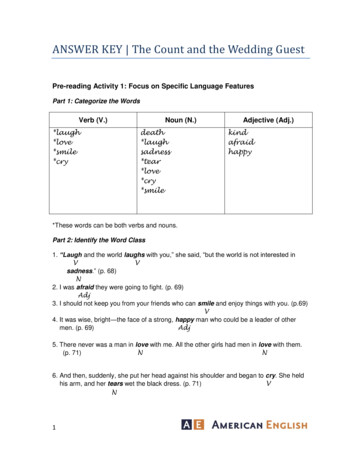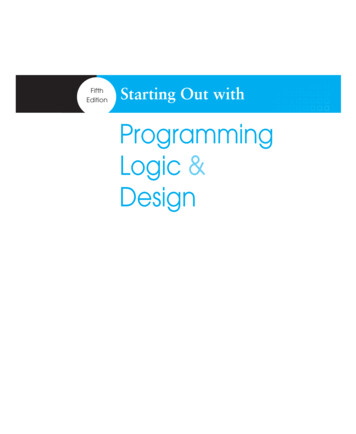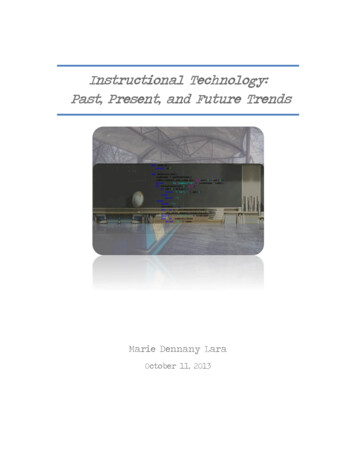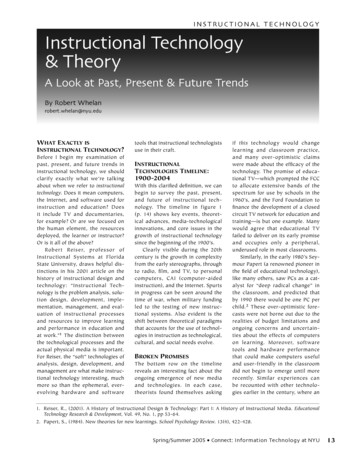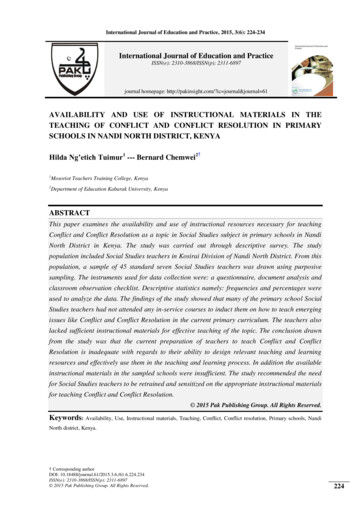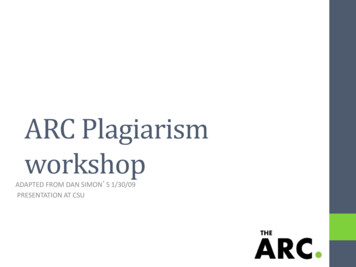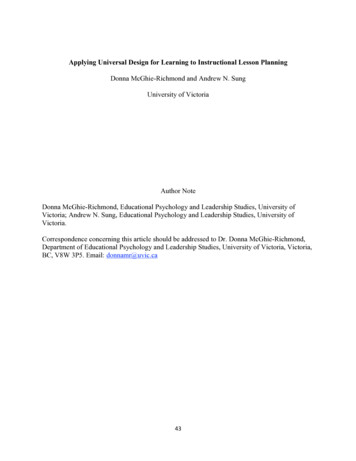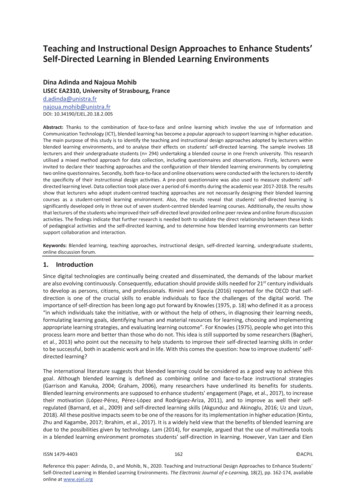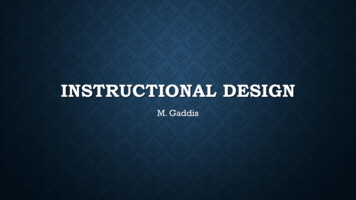
Transcription
INSTRUCTIONAL DESIGNM. Gaddis
WHAT IS INSTRUCTIONAL DESIGN?Definition“the systematic and reflective process of translating principles oflearning and instruction into plans for instructional materials, activities,information resources, and evaluation (Smith & Ragan, 2005).Smith, P. L., & Ragan, T. J. (2005). Instructional design (3rd ed.). Hoboken,NJ: Wiley & Sons, Inc.
SYSTEMS THEORYSeminal work in instructional design arises from systems theory Challenges reductionism; a system is greater than the sum of its parts. Equifinality – the end result of an open system can be achieved by a numberof specific pathways that arise due to interactions with the environmentalcontextuwf.edu A general system is inherently a closed one, which leads to stabilitySystems theory is synthesized in:Richey, R., Klein, J., & Tracey, M. (2011). The instructional design knowledge base:Theory, research, and practice (1st ed.). New York: Routledge.Seminal work in systems theoryPutnam, H. (1964). The complete conversationalist: A “systems approach” to thephilosophy of language. In M. C. Mesarovic (Ed.), Views on generalsystems theory: Proceedings of the Second Systems Symposium. CaseInstitute of Technology (pp. 89-105). New York: John Wiley & Sons, Inc.freshbrainz.blogspot.com
HOW ARE INSTRUCTIONAL DESIGN ANDLEARNING THEORY DIFFERENT?Learner characteristics versus design characteristics Instructional designers (ID) are guided by learning theory; Learning theories help IDs to understandhow the mind of the learner works Educators (Subject Matter Experts- SMEs) can promote learning in their classrooms by working withIDs who know how systems workAn effective team includes both SMEs and IDs Example- an interior designer and an engineer are required to build a safe and comfortable home.Selected ReadingMilman, L. B., & Kilbane, C. R. (2013). Teaching models: Designing instruction for 21stcentury learners. Upper Saddle River, NJ: PearsonGustafson, K. L., & Branch, R. M. (2002). Survey of instructional development models(4th ed.). Syracuse, NY: Syracuse University.
SELECTED WORK IN FOUNDATIONALLEARNING THEORIES (1 OF 3)BehaviorismBiology drives human behavior without mental control; Response to stimuli isuncontrollable; Educational environments provide stimuli to facilitate learning(response)Selected ReadingWatson, J. B. (1925). Behaviorism. New Brunswick, NJ: Transaction mes Watson(1878-1958)American Psychologist
SELECTED WORK IN FOUNDATIONALLEARNING THEORIES (2 OF 3)CognitivismThinking impacts behavior and therefore, thinking is not a behavior; train the mindto learn by thinking Cognitive architecture is a reductionist principleeduc6040fall10.wikispaces.comSelected ReadingBandura, A. (2001). Social cognitive theory: An agentic perspective. Annualreview of psychology, 52, 1-26.Bargh, J. A., & Ferguson, M. J. (2000). Beyond behaviorism: on the automaticity ofhigher mental processes. Psychological bulletin, 126, 925.Garrison, D. R., Cleveland-innes, M., & Fung, T. S. (2010). Exploring causalrelationship among teaching, cognitive and social presence: Studentperceptions of the community of inquiry framework. The Internet andHigher Education, 13, 31-36.hlwiki.slais.ubc.ca
SELECTED WORK IN FOUNDATIONALLEARNING THEORIES (3 OF 3)ConstructivismKnowledge is accumulated through life experiences and selfreflection about those experiences Emergent learning arises (not reductionism)Selected ReadingMerrill, M. D. (1991). Constructivism and Instructional Design.Educational technology, 31(5), 45-53.Merrill, M. D. (2002). First principles of instruction. Educationaltechnology, research, and development, 50, 43-59.www.scoop.it
SUMMARIZING LEARNINGTHEORIESDon’t let thishappen to you!Your instructionalplan must alignwith theeducational goalsfor your studentswww.partiallyexaminedlife.comSynthesizing Learning TheoriesErtmer, P. A., & Newby, T. J. (1993). Behaviorism,cognitivism, constructivism: Comparingcritical features from an instructional designperspective. Performance improvementquarterly, 6(4), 50-72.
HOW DO EDUCATORS USE INSTRUCTIONALDESIGN THEORY? (1 OF 3)Master courses versus educator-designed courses The strongest applications of ID theory exist in master coursesdeveloped by ID and SME teams Educator-designed courses are potentially more creative but lessaccountable due to the impermanent course designedutechdebate.orgTechnology-mediated learning Online and blended learning employ more ID theory because system design is central to learningsuccess Juxtaposed to a expert scholar model in which the knowledge is held by the human professor and istransferred to the student through didactic instructionSelected ReadingSiemens, G. (2005). Connectivism: A learning theory for the digital age. International journal ofinstructional technology and distance learning.
HOW DO EDUCATORS USE INSTRUCTIONALDESIGN THEORY? (2 OF 3)The course map A tool used in backwards design, aka the ADDIEmodel The course map links every course feature to acourse learning outcome The instructional design is illustrated in the coursemapSelected ReadingWiggins, G. P., & Mctighe, J. (2005). Understanding bydesign. Retrieved ified/file/wiggins sample units/ubd - 1 parkway july 2009.pdfwww.lovegolfdesign.comExample:You can not get to the 18th hole without a wellplanned golf course that links one hole to thenext .and of course it would do you no good totry for the 18th hole without traveling the “course.”
HOW DO EDUCATORS USEINSTRUCTIONAL DESIGNTHEORY? (3 OF 3)Academic accountability In the Era of Mass Education, accountability is a central principle ID provides accountable reasoning for course design Using ID theory solidifies the connection between effectiveinstruction and student retention None of this was necessary in the traditional American academicmodel where the elite professor controlled the educationalexperience with little oversightReading about the history of American higher educationThelin, J. R., & Gasman, M. (2003). Historical Overview of AmericanHigher Education. In S. R. Komives, & D. B. Woodward Jr.(Eds.), Student Services: A Handbook for the Profession (pp.3-23). San Francisco, CA: Jossey-Bass.
INSTRUCTIONAL DESIGN MODELSA glimpse of what is possible
THE ADDIE MODELLead with assessment The ADDIE model is a ID design strategy in which designersfirst develop assessments aligned to course learningoutcomes The course map is where this alignment is publishedThe role of the educator The educator carries out the instructional design May or may not be part of the design process depending onwhether or not the educator teaching the course is also theSMETechnology applications Online education is facilitated by the purposeful use of theADDIE model in course designMedia applications The ADDIE model identifies media applications as part of thedesigned learning activities for a coursewww.csuchico.eduSelected readingGustafson, K. L., & Branch, R. M. (2002). Survey ofinstructional development models (4th ed.).Syracuse, NY: Syracuse University.
INFORMATION PROCESSINGTHEORYInformation processing theory arises from Cognitivism and behaviorism (procedural knowledge) Brain biologyIn order to deepen knowledge, the information needs to beheld in the working memory long enough to transferinformation into the long-term memoryThe role of the educator The educator stimulates the learner with discussion andlearning activities intended to increase the time during which astudent interacts with the information to be processedTechnology applications Adaptive study resources developed by textbook publishersprovide excellent control of information processingpsysc613.wikispaces.comMedia applications Multimodal learning activities increase information processing by delivering information with auditory, visual andkinesthetic stimuliSelected ReadingConklin, H. M., Luciana, M., Hooper, C. J., & Yarger, R. S. (2007). Working memory performance in typically developingchildren and adolescents: Behavioral evidence of protracted frontal lobe development. Developmentalneuropsychology, 31, 103-128Simon, H. A. (1978). Information-processing theory of human problem solving. Handbook of learning and cognitiveprocesses, 5, 271-295.I asked my daughterwhat learning was andshe described thistreasure chest not toobad for a seven-year old.
THE 5E MODEL OFSCIENCE INSTRUCTIONThe 5E model arises from Constructivism and cognitivism Inquiry-based learningThe role of the educator The educator engages, guides, and assesses students By following the model repeatedly in a classroom, cognitiveapprenticeship ensues as students discover that the 5Es are process ofthinkingwww.aps.orgSelected ReadingsBangert, A. (2008). The influence of social presence and teachingpresence on the quality of online critical inquiry. Journal ofTechnology applicationsComputing in Higher Education, 20, 34-61.Bybee, R. W. (2009). The BSCS 5E instructional model and 21st century Formative activities can be adapted to online or hybrid classroomsskills. 5415 Mark Dabling Boulevard, Colorado Springs, CO 80918: Engage- didactic instruction delivered online (ex. Bozeman Science)BSCS. Explore- lab activities at home for online studentsLee, V. S. (2012). What is inquiry‐guided learning? New directions forteaching and learning, 129, 5-14. Explain- online discussionsJordan, J., Jalali, A., Clarke, S., Dyne, P., Spector, T., & Coates, W. (2013).Media applicationsAsynchronous vs didactic education: it’s too early to throw in thetowel on tradition. BMC medical education, 13. Retrieved from Media-based engagement tools are a great way to introduce a student tohttp://www.biomedcentral.com/1472-6920/13/105/a learning topicKubieck, J. P. (2005). Inquiry-based learning, the nature of science, and Media-based assessments offer opportunities for student collaborationcomputer technology: New possibilities in science education.and competency demonstrationCanadian Journal of Learning and Technology/La revue canadiennede l’apprentissage et de la technologie, 31.
WHAT INSTRUCTIONAL DESIGN RESOURCESARE AVAILABLE TO EDUCATORS?Leading Internet resource Instructional Design CentralProfessional organizations In addition to those listed here, social media groups htm/IDC instructionaldesignmodels.htm
TAKE HOME MESSAGESWhat is a teaching philosophy?When asked to write a teaching philosophy, think about your perspectives how students learn. Don’t be too dogmatic – there is room for a little of everythingWhat is an instructional model?When asked to design a course, think about what your students will have to learn and what they will berequired to do to demonstrate their learning. Don’t be too dogmatic – there is room for a little of everythingExperience Counts! Constructivism is real.Don’t let the literature bully you around. Instead, think about what you do and how that fits with the theoriesyou read. This is a self-supportive approach.
REFERENCES-AVAILABLE IN A COURSEPACK PROVIDED WITH THIS WEBINARBandura, A. (2001). Social cognitive theory: An agentic perspective. Annual review of psychology, 52, 1-26.Bangert, A. (2008). The influence of social presence and teaching presence on the quality of online critical inquiry. Journal of Computing in Higher Education, 20, 34-61. http://dx.doi.org/Retrieved fromBargh, J. A., & Ferguson, M. J. (2000). Beyond behaviorism: on the automaticity of higher mental processes. Psychological bulletin, 126, 925.Conklin, H. M., Luciana, M., Hooper, C. J., & Yarger, R. S. (2007). Working memory performance in typically developing children and adolescents: Behavioral evidence of protracted frontal lobe development. Developmentalneuropsychology, 31, 103-128.Duschl, R. A., & Bybee, R. W. (2014). Planning and carrying out investigations; an entry to learning and to teacher professional development around NGSS science and engineering practices. International Journal of STEM Education,1, 1-9.Garrison, D. R., Cleveland-innes, M., & Fung, T. S. (2010). Exploring causal relationship among teaching, cognitive and social presence: Student perceptions of the community of inquiry framework. The Internet and HigherEducation, 13, 31-36.Gustafson, K. L., & Branch, R. M. (2002). Survey of instructional development models (4th ed.). Syracuse, NY: Syracuse University.Jordan, J., Jalali, A., Clarke, S., Dyne, P., Spector, T., & Coates, W. (2013). Asynchronous vs didactic education: it’s too early to throw in the towel on tradition. BMC medical education, 13. Retrieved Kubieck, J. P. (2005). Inquiry-based learning, the nature of science, and computer technology: New possibilities in science education. Canadian Journal of Learning and Technology/La revue canadienne de l’apprentissage et de latechnologie, 31.Lee, V. S. (2012). What is inquiry‐guided learning? New directions for teaching and learning, 129, 5-14.Merrill, M. D. (2002). First principles of instruction. Educational technology, research, and development, 50, 43-59.Milman, L. B., & Kilbane, C. R. (2013). Teaching models: Designing instruction for 21st century learners. Upper Saddle River, NJ: PearsonPutnam, H. (1964). The complete conversationalist: A “systems approach” to the philosophy of language. In M. C. Mesarovic (Ed.), Views on general systems theory: Proceedings of the Second Systems Symposium. Case Institute ofTechnology (pp. 89-105). New York: John Wiley & Sons, Inc.Richey, R., Klein, J., & Tracey, M. (2011). The instructional design knowledge base: Theory, research, and practice (1st ed.). New York: Routledge.Siemens, G. (2005). Connectivism: A learning theory for the digital age. International journal of instructional technology and distance learning.Simon, H. A. (1978). Information-processing theory of human problem solving. Handbook of learning and cognitive processes, 5, 271-295.Smith, P. L., & Ragan, T. J. (2005). Instructional design (3rd ed.). Hoboken, NJ: Wiley & Sons, Inc.Thelin, J. R., & Gasman, M. (2003). Historical Overview of American Higher Education. In S. R. Komives, & D. B. Woodward Jr. (Eds.), Student Services: A Handbook for the Profession (pp. 3-23). San Francisco, CA: Jossey-Bass.
SYSTEMS THEORY Seminal work in instructional design arises from systems theory Challenges red
